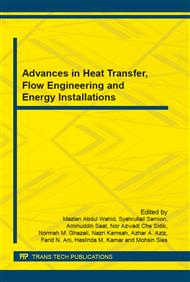p.107
p.111
p.117
p.122
p.127
p.132
p.142
p.147
p.152
Heat Transfer Enhancement in a Microchannel Heat Sink with Trapezoidal Cavities on the Side Walls
Abstract:
The present study focuses on the numerical study of thermal and flow characteristics in a microchannel heat sink with alternating trapezoidal cavities in sidewall (MTCS). The effects of flow rate and heat flux on friction factor and Nusselt are presented. The results showed considerable improvement heat transfer performance micro channel heat sink with alternating trapezoidal cavities in sidewall with an acceptable pressure drop. The heat transfer rate has improved in the cavity area due the greater fluid mixing in fluid vortices and thermal boundary layer disruption. The slipping over the reentrant cavities and pressure gain reduces pressure drop appears as the reason behind of only minor pressure drop due to the cavities.
Info:
Periodical:
Pages:
127-131
Citation:
Online since:
January 2016
Price:
Сopyright:
© 2016 Trans Tech Publications Ltd. All Rights Reserved
Share:
Citation:


